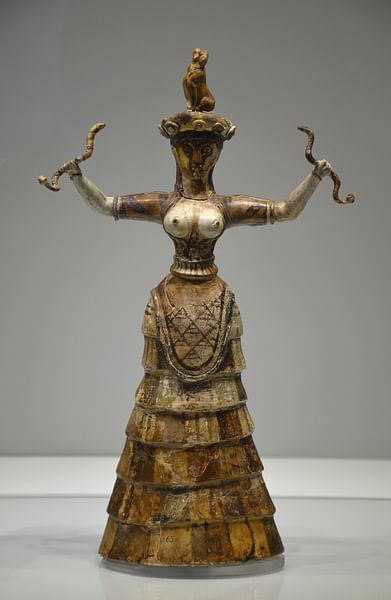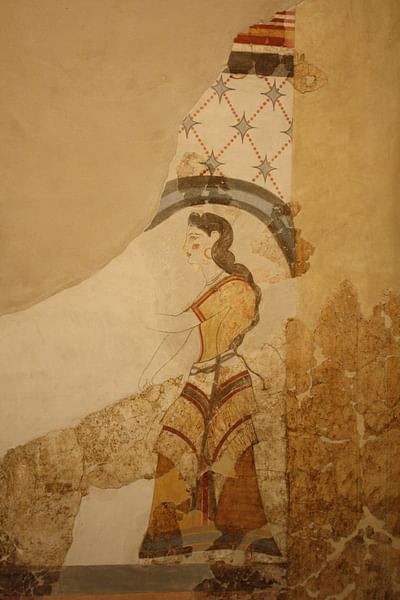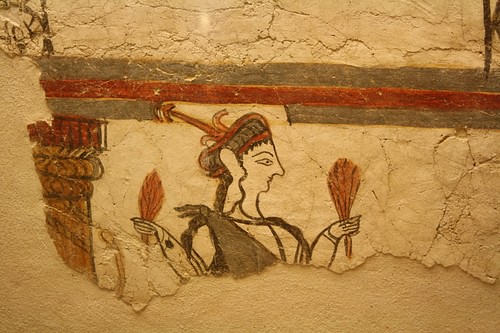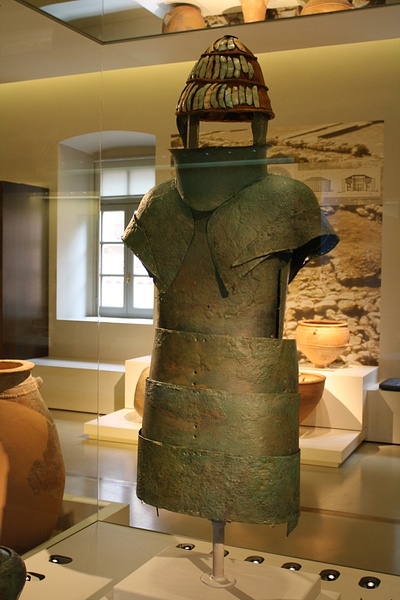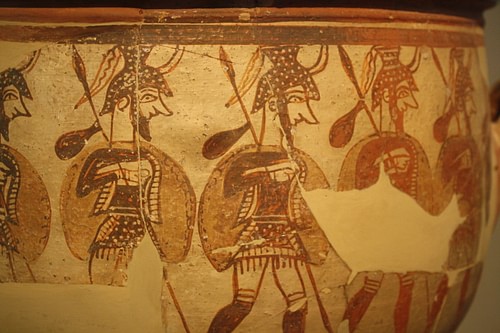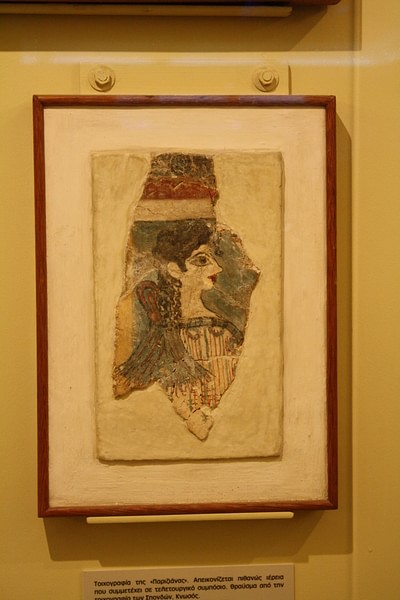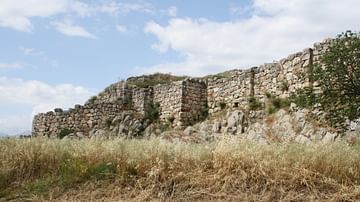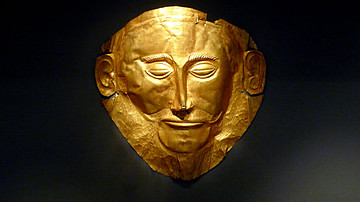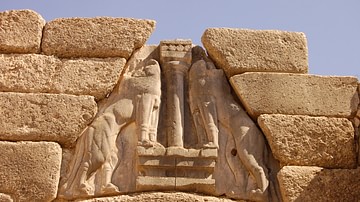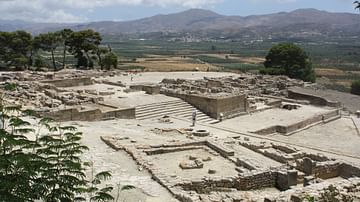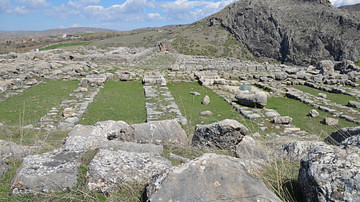Dress and appearance in Bronze Age Greece (c. 3100 BCE - c. 1100 BCE) played a part in defining gender roles and emphasising idealized beauty that planted the seed for modern-day standards. The Minoans turned the island of Crete into a Mediterranean powerhouse and dominated Aegean culture until around 1450 BCE when the Mycenaean civilization from the Greek mainland peaked and wrested control. Frescoes and figurines uncovered from this era reveal a fabulously colourful society that expressed itself through fashion, hair, and accessories. Both Minoan and Mycenaean women sought a pinched waist to achieve the epitome of a feminine aesthetic. The fashion of Mycenaean men, however, expressed their warlike temperament, in contrast to their Minoan counterparts, who embodied display and splendour.
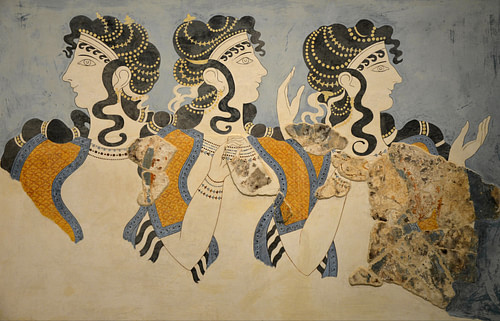
Minoan Women
Women are heavily represented amongst the archaeological finds from Knossos, Akrotiri, and other Minoan hubs. One of the most beautiful examples is the Snake Goddess Figurine which depicts the archetype of Minoan dress. This woman wears a flounced, layered skirt that falls to the ground. Her bodice has short sleeves and a scalloped neckline which reveals and accentuates her breasts. This is mirrored in the colourful frescoes which emphasise bright, eye-catching fabrics dyed a myriad of colours. Bold primary colours – reds, yellows, and blues − dominate the pattern scheme. To get these shades, the Minoans took advantage of the available natural resources. Saffron – now the world’s most expensive spice – was used to acquire yellow and murex sea snails created a rich purple.
One of the most interesting aspects of female dress was the use of corsets or tight thick belts to create an hour-glass figure. Artworks suggest that the wasp-waist was highly idealised in Minoan culture and body modification may have been implemented to achieve this. Corsets have, of course, gone in and out of fashion in the thousands of years since their early Cretan use. Minoan women also wore jewellery to frame their features. Hoop earrings, necklaces, and bangles were all popular forms of expression and decoration − gold and glass beads were used to give outfits that glamourous touch.
In the frescoes, women have black hair braided into long tendrils or locks. Their skin, in contrast, is typically a pale white, implying that the ideal women would have spent significant time indoors and that the archetype of feminine beauty could be obtained by focusing on domestic duties.
Mycenaean Women
Mycenaean fashion was heavily influenced by its Minoan predecessor. Mainland Greek women adopted a similar flounced skirt and silhouette. However, it is notable that at certain points in Mycenaean history a more conservative closed bodice was preferred and, on occasion, just a simplistic tunic, sometimes belted. They wore knit shawls or cloaks over their dresses and secured their elaborate, twisted hairstyles with ivory hairpins.
Mycenaean women are often depicted with a distinctive accessory: the polos. A polos is a round, cylindrical crown, shaped almost like a side-turned wheel that was worn on the head. It was commonly sported by powerful women such as goddesses.

Minoan Men
Minoan men preferred to keep clothing to a minimum and are usually shown with a bare torso. Like their female counterparts, they were not shy and enjoyed showing off their upper bodies which were well-muscled from competing in sports such as bull-leaping and boxing. Breechcloths, loincloths, and kilts were popular, especially when paired with a decorative codpiece. These garments were multicoloured with yellows, blues, and whites. Minoan men are also shown wearing hats with long, vibrant feathers protruding from their centre, and they accessorised with necklaces, bracelets, and ornamental bands that encircled their biceps. The designs on gold signet rings held particular significance. They served as seals, effectively a prehistoric signature or identity marker that could be impressed into clay. The Akrotiri Boxer Fresco shows two young boys boxing, however, only the boy on the left is adorned with jewellery which may indicate that such items were symbols of wealth or status.

Minoan men on frescoes are clean-shaven, and judging by the obsidian razor blades discovered in Early Bronze Age graves, a neat and presentable appearance was highly important. Minoan men are typically shown sporting several long black locks with the rest of their hair cut short. In contrast to the women, they are depicted with reddish-brown skin, similar to frescoes seen in Egypt. To acquire this darker tone, the ideal man would have spent a significant amount of time engaging in outdoor activities such as hunting, fishing, and athletics. The exception to this is the famous Priest-King Fresco. By his codpiece, breechcloth, and muscled torso this individual appears to be a man. However, his skin has a pinkish hue far paler than the typical man’s skin but darker than a woman’s. Scholars argue that this could indicate a man from a high-status family who did not need to work outdoors.
Mycenaean Men
Mycenaean men liked to cover up slightly more than the Minoans. Kilts, tunics, and cloaks became fashion staples and are debatably less decorative. The Mycenaeans were known for their military prowess across the Aegean, and consequently, battle armour would have been a common feature of the male wardrobe. Their helmets consisted of a leather or felt cap (sometimes embellished with a plume) that was reinforced with boar tusks. The effort to make a single helmet would have been immense, involving the hunting of dozens of boars.
The Dendra Panoply exhibits full body armour, including a helmet, bronze breastplate, layered kilt, and shoulder guards which would have been secured with leather straps. In total, armour weighed a colossal 15 kg (33 lb), meaning serious strength and physical fitness would have certainly been an advantage, if not a necessity, in the Mycenaean army. Bronze greaves would have also protected the shin and leather kilts or corselets decorated with metal studs are depicted on objects such as the Warrior Vase.
Comparisons
Developments in male dress from the Minoan to the Mycenaean period reflect a growing prevalence of war and military importance. This is not to suggest that the Minoans did not engage in battle. Their position within the Aegean made them a prime target, meaning they would have almost certainly been skilled at defending themselves, but it was Mycenaean warfare that became a central component of Greek society. This is evidenced by the concentration of weapons and military equipment in the Mycenaean shaft graves. These men made it clear that they wanted to be remembered as warriors and fighters, leaving behind a legacy of strength, influence, and power.
There is very little difference between the fashion styles of Minoan and Mycenaean women which suggests that the female role remained relatively similar throughout the Bronze Age as there was no need to substantially alter the practicality of the silhouette. That being said, during the Minoan period women were the focal point of religion; represented as goddesses and priestesses at the forefront of ritual and ceremony. Their garments are more elaborate and intricate, and it has been argued that this indicates they played a more central role in Bronze Age religion (and possibly even politics) than Mycenaean women, who are often depicted with children and, consequently, greater familial and maternal responsibilities.
Legacy
What is captivating is that these garments have the power to bring Greek myths to life. The Bronze Age is also known as the Heroic Age because it was thought to be the time in which mythical figures roamed the Earth. When we look at the frescoes, it is easy to imagine the colourful Minoan dress Ariadne would have worn as she gave her magical string to Theseus to guide him through the labyrinth or the glorious Mycenaean armour Agamemnon would have sported as he led his troops into battle against the Trojans.
Between c. 1250 - c. 1100 BCE, a series of earthquakes, droughts, famines, wars, and the invasion of the mysterious Sea Peoples whom we know little about brought on the Bronze Age Collapse. This series of disasters brought down some of the greatest civilisations the world has ever known and heralded the Greek Dark Ages (c. 1100 - c. 750 BCE) in which the Bronze Age styles were eventually replaced by the peplos and the chiton − the clothing we, in the modern day, most commonly associate with ancient Greece. In cultural hubs like Athens, clothing became more conservative for women whilst for men, nudity was idealised and normalised in certain social settings, signalling a widening of the gender divide.
3,000 years after the Bronze Age Collapse, the styles and beauty standards still resonate with a modern audience. Hourglass figures and well-muscled bodies are still glorified, and pinched-waist dresses appear commonly in the media. Although separated by an incredibly vast gap of time, it is fascinating to think that our prehistoric ancestors shared our aesthetic ambitions and tastes.
